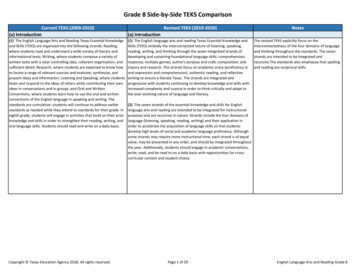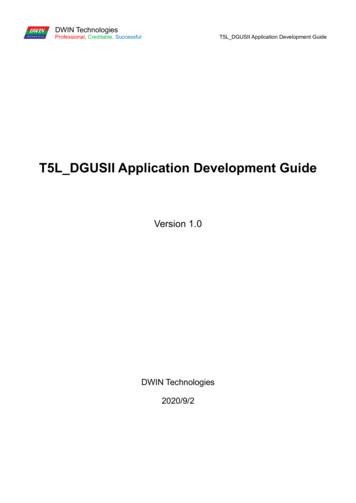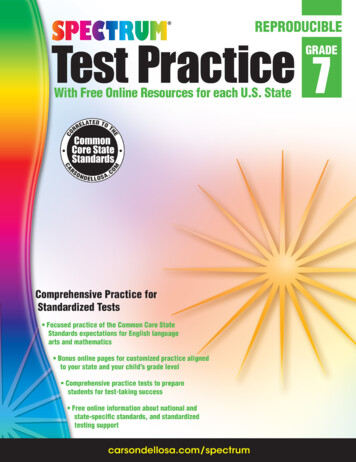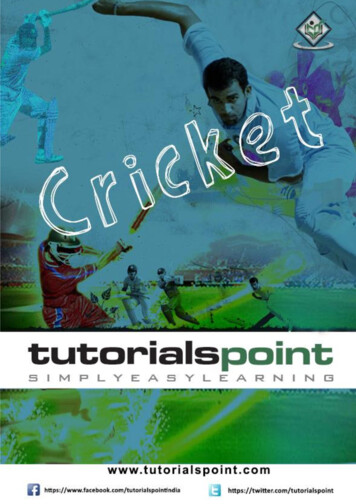
Transcription
Grade 8 Side-by-Side TEKS ComparisonCurrent TEKS (2009-2010)(a) Introduction(1) The English Language Arts and Reading Texas Essential Knowledgeand Skills (TEKS) are organized into the following strands: Reading,where students read and understand a wide variety of literary andinformational texts; Writing, where students compose a variety ofwritten texts with a clear controlling idea, coherent organization, andsufficient detail; Research, where students are expected to know howto locate a range of relevant sources and evaluate, synthesize, andpresent ideas and information; Listening and Speaking, where studentslisten and respond to the ideas of others while contributing their ownideas in conversations and in groups; and Oral and WrittenConventions, where students learn how to use the oral and writtenconventions of the English language in speaking and writing. Thestandards are cumulative--students will continue to address earlierstandards as needed while they attend to standards for their grade. Ineighth grade, students will engage in activities that build on their priorknowledge and skills in order to strengthen their reading, writing, andoral language skills. Students should read and write on a daily basis.Copyright Texas Education Agency 2018. All rights reserved.Revised TEKS (2019-2020)Notes(a) Introduction(1) The English language arts and reading Texas Essential Knowledge andSkills (TEKS) embody the interconnected nature of listening, speaking,reading, writing, and thinking through the seven integrated strands ofdeveloping and sustaining foundational language skills; comprehension;response; multiple genres; author's purpose and craft; composition; andinquiry and research. The strands focus on academic oracy (proficiency inoral expression and comprehension), authentic reading, and reflectivewriting to ensure a literate Texas. The strands are integrated andprogressive with students continuing to develop knowledge and skills withincreased complexity and nuance in order to think critically and adapt tothe ever-evolving nature of language and literacy.The revised TEKS explicitly focus on theinterconnectedness of the four domains of languageand thinking throughout the standards. The sevenstrands are intended to be integrated andrecursive.The standards also emphasize that spellingand reading are reciprocal skills.(2) The seven strands of the essential knowledge and skills for Englishlanguage arts and reading are intended to be integrated for instructionalpurposes and are recursive in nature. Strands include the four domains oflanguage (listening, speaking, reading, writing) and their application inorder to accelerate the acquisition of language skills so that studentsdevelop high levels of social and academic language proficiency. Althoughsome strands may require more instructional time, each strand is of equalvalue, may be presented in any order, and should be integrated throughoutthe year. Additionally, students should engage in academic conversations,write, read, and be read to on a daily basis with opportunities for crosscurricular content and student choice.Page 1 of 29English Language Arts and Reading Grade 8
Grade 8 Side-by-Side TEKS ComparisonCurrent TEKS (2009-2010)Revised TEKS (2019-2020)Notes(3) Text complexity increases with challenging vocabulary, sophisticatedStudents will build on the standards and skills learnedsentence structures, nuanced text features, cognitively demanding content, in prior grade levels with additional depth andand subtle relationships among ideas (Texas Education Agency, STAARcomplexity in this grade level.Performance Level Descriptors, 2013). As skills and knowledge are obtainedin each of the seven strands, students will continue to apply earlierstandards with greater depth to increasingly complex texts in multiplegenres as they become self-directed, critical learners who workcollaboratively while continuously using metacognitive skills.(2) For students whose first language is not English, the students'native language serves as a foundation for English language acquisition.(2)(A) English language learners (ELLs) are acquiring English, learningcontent in English, and learning to read simultaneously. For this reason,it is imperative that reading instruction should be comprehensive andthat students receive instruction in phonemic awareness, phonics,decoding, and word attack skills while simultaneously being taughtacademic vocabulary and comprehension skills and strategies. Readinginstruction that enhances ELL's ability to decode unfamiliar words andto make sense of those words in context will expedite their ability tomake sense of what they read and learn from reading. Additionally,developing fluency, spelling, and grammatical conventions of academiclanguage must be done in meaningful contexts and not in isolation.Copyright Texas Education Agency 2018. All rights reserved.Page 2 of 29English Language Arts and Reading Grade 8
Grade 8 Side-by-Side TEKS ComparisonCurrent TEKS (2009-2010)Revised TEKS (2019-2020)Notes(2)(B) For ELLs, comprehension of texts requires additional scaffolds tosupport comprehensible input. ELL students should use the knowledgeof their first language (e.g., cognates) to further vocabularydevelopment. Vocabulary needs to be taught in the context ofconnected discourse so that language is meaningful. ELLs must learnhow rhetorical devices in English differ from those in their nativelanguage. At the same time English learners are learning in English, thefocus is on academic English, concepts, and the language structuresspecific to the content.(4) English language learners (ELLs) are expected to meet standards in asecond language; however, their proficiency in English influences the abilityto meet these standards. To demonstrate this knowledge throughout thestages of English language acquisition, comprehension of text requiresadditional scaffolds such as adapted text, translations, native languagesupport, cognates, summaries, pictures, realia, glossaries, bilingualdictionaries, thesauri, and other modes of comprehensible input. ELLs canand should be encouraged to use knowledge of their first language toenhance vocabulary development; vocabulary needs to be in the context ofconnected discourse so that it is meaningful. Strategic use of the student'sfirst language is important to ensure linguistic, affective, cognitive, andacademic development in English.The revised standards focus on the importance ofencouraging EL students to use their native languageto enhance their learning and on providingscaffolded instruction to support the needs of ELs.(2)(C) During initial stages of English development, ELLs are expectedto meet standards in a second language that many monolingual Englishspeakers find difficult to meet in their native language. However,English language learners' abilities to meet these standards will beinfluenced by their proficiency in English. While English languagelearners can analyze, synthesize, and evaluate, their level of Englishproficiency may impede their ability to demonstrate this knowledgeduring the initial stages of English language acquisition. It is also criticalto understand that ELLs with no previous or with interrupted schoolingwill require explicit and strategic support as they acquire English andlearn to learn in English simultaneously.(3) To meet Public Education Goal 1 of the Texas Education Code,§4.002, which states, "The students in the public education system willdemonstrate exemplary performance in the reading and writing of theEnglish language," students will accomplish the essential knowledge,skills, and student expectations at Grade 8 as described in subsection(b) of this section.Copyright Texas Education Agency 2018. All rights reserved.Page 3 of 29English Language Arts and Reading Grade 8
Grade 8 Side-by-Side TEKS ComparisonCurrent TEKS (2009-2010)Revised TEKS (2019-2020)Notes(5) Current research stresses the importance of effectively integratingsecond language acquisition with quality content area education in order toensure that ELLs acquire social and academic language proficiency inEnglish, learn the knowledge and skills, and reach their full academicpotential. Instruction must be linguistically accommodated in accordancewith the English Language Proficiency Standards (ELPS) and the student'sEnglish language proficiency levels to ensure the mastery of knowledge andskills in the required curriculum is accessible. For a further understanding ofsecond language acquisition needs, refer to the ELPS and proficiency-leveldescriptors adopted in Chapter 74, Subchapter A, of this title (relating toRequired Curriculum).This includes specific information to guide theinstruction of ELs in their acquisition of reading skills,their vocabulary development, and the improvementof their English-language proficiency.(4) To meet Texas Education Code, §28.002(h), which states, ". eachschool district shall foster the continuation of the tradition of teachingUnited States and Texas history and the free enterprise system inregular subject matter and in reading courses and in the adoption oftextbooks," students will be provided oral and written narratives aswell as other informational texts that can help them to becomethoughtful, active citizens who appreciate the basic democratic valuesof our state and nation.(6) Oral language proficiency holds a pivotal role in school success; verbal There is an emphasis on the role of oral languageengagement must be maximized across grade levels (Kinsella, 2010). Inproficiency as it relates to student succes at school.order for students to become thinkers and proficient speakers in science,social studies, mathematics, fine arts, language arts and reading, and careerand technical education, they must have multiple opportunities to practiceand apply the academic language of each discipline (Fisher, Frey, &Rothenberg, 2008).(7) Statements that contain the word "including" reference content thatmust be mastered, while those containing the phrase "such as" areintended as possible illustrative examples.Copyright Texas Education Agency 2018. All rights reserved.Page 4 of 29English Language Arts and Reading Grade 8
Grade 8 Side-by-Side TEKS ComparisonCurrent TEKS (2009-2010)(b) Knowledge and skillsRevised TEKS (2019-2020)(b) Knowledge and skills(1) Reading/Fluency. Students read grade-level text with fluency andcomprehension. Students are expected to adjust fluency when readingaloud grade-level text based on the reading purpose and the nature ofthe text.(3) Developing and sustaining foundational language skills: listening,speaking, reading, writing, and thinking--fluency. The student reads gradelevel text with fluency and comprehension. The student is expected toadjust fluency when reading grade-level text based on the reading purpose.(2) Reading/Vocabulary Development. Students understand newvocabulary and use it when reading and writing. Students are expectedto:(A) determine the meaning of grade-level academic English wordsderived from Latin, Greek, or other linguistic roots and affixes;(2) Developing and sustaining foundational language skills: listening,speaking, reading, writing, and thinking--vocabulary. The student usesnewly acquired vocabulary expressively. The student is expected to:(C) determine the meaning and usage of grade-level academic Englishwords derived from Greek and Latin roots such as ast, qui, path,mand/mend, and duc.(2) Reading/Vocabulary Development. Students understand newvocabulary and use it when reading and writing. Students are expectedto:(B) use context (within a sentence and in larger sections of text) todetermine or clarify the meaning of unfamiliar or ambiguous words orwords with novel meanings;(2) Developing and sustaining foundational language skills: listening,speaking, reading, writing, and thinking--vocabulary. The student usesnewly acquired vocabulary expressively. The student is expected to:(B) use context within or beyond a paragraph to clarify the meaning ofunfamiliar or ambiguous words; andNotes(2) Reading/Vocabulary Development. Students understand newvocabulary and use it when reading and writing. Students are expectedto:(C) complete analogies that describe a function or its description (e.g.,pen:paper as chalk: or soft:kitten as hard: );(2) Reading/Vocabulary Development. Students understand newvocabulary and use it when reading and writing. Students are expectedto:(D) identify common words or word parts from other languages thatare used in written English (e.g., phenomenon, charisma, chorus, passé,flora, fauna); andCopyright Texas Education Agency 2018. All rights reserved.Page 5 of 29English Language Arts and Reading Grade 8
Grade 8 Side-by-Side TEKS ComparisonCurrent TEKS (2009-2010)(2) Reading/Vocabulary Development. Students understand newvocabulary and use it when reading and writing. Students are expectedto:(E) use a dictionary, a glossary, or a thesaurus (printed or electronic) todetermine the meanings, syllabication, pronunciations, alternate wordchoices, and parts of speech of words.Revised TEKS (2019-2020)Notes(2) Developing and sustaining foundational language skills: listening,speaking, reading, writing, and thinking--vocabulary. The student usesnewly acquired vocabulary expressively. The student is expected to:(A) use print or digital resources to determine the meaning, syllabication,pronunciation, word origin, and part of speech;(3) Comprehension of Literary Text/Theme and Genre. Studentsanalyze, make inferences and draw conclusions about theme and genrein different cultural, historical, and contemporary contexts and provideevidence from the text to support their understanding. Students areexpected to:(A) analyze literary works that share similar themes across cultures;(3) Comprehension of Literary Text/Theme and Genre. Studentsanalyze, make inferences and draw conclusions about theme and genrein different cultural, historical, and contemporary contexts and provideevidence from the text to support their understanding. Students areexpected to:(B) compare and contrast the similarities and differences inmythologies from various cultures (e.g., ideas of afterlife, roles andcharacteristics of deities, purposes of myths); and(3) Comprehension of Literary Text/Theme and Genre. Studentsanalyze, make inferences and draw conclusions about theme and genrein different cultural, historical, and contemporary contexts and provideevidence from the text to support their understanding. Students areexpected to:(C) explain how the values and beliefs of particular characters areaffected by the historical and cultural setting of the literary work.Copyright Texas Education Agency 2018. All rights reserved.(7) Multiple genres: listening, speaking, reading, writing, and thinkingusing multiple texts--literary elements. The student recognizes andanalyzes literary elements within and across increasingly complextraditional, contemporary, classical, and diverse literary texts. The studentis expected to:(D) explain how the setting influences the values and beliefs of characters.Page 6 of 29English Language Arts and Reading Grade 8
Grade 8 Side-by-Side TEKS ComparisonCurrent TEKS (2009-2010)Revised TEKS (2019-2020)Notes(4) Comprehension of Literary Text/Poetry. Students understand,make inferences and draw conclusions about the structure andelements of poetry and provide evidence from text to support theirunderstanding. Students are expected to compare and contrast therelationship between the purpose and characteristics of differentpoetic forms (e.g., epic poetry, lyric poetry).(8) Multiple genres: listening, speaking, reading, writing, and thinkingThe cognitive complexity of this SE requires theusing multiple texts--genres. The student recognizes and analyzes genrestudent to analyze.specific characteristics, structures, and purposes within and acrossincreasingly complex traditional, contemporary, classical, and diverse texts.The student is expected to:(B) analyze the effect of graphical elements such as punctuation and linelength in poems across a variety of poetic forms such as epic, lyric, andhumorous poetry;(5) Comprehension of Literary Text/Drama. Students understand,make inferences and draw conclusions about the structure andelements of drama and provide evidence from text to support theirunderstanding. Students are expected to analyze how differentplaywrights characterize their protagonists and antagonists through thedialogue and staging of their plays.(8) Multiple genres: listening, speaking, reading, writing, and thinkingThe cognitive complexity of this SE requires theusing multiple texts--genres. The student recognizes and analyzes genrestudent to analyze. Instruction of drama isspecific characteristics, structures, and purposes within and acrossencompassed in SE 8(C).increasingly complex traditional, contemporary, classical, and diverse texts.The student is expected to:(C) analyze how playwrights develop dramatic action through the use ofacts and scenes;(6) Comprehension of Literary Text/Fiction. Students understand,make inferences and draw conclusions about the structure andelements of fiction and provide evidence from text to support theirunderstanding. Students are expected to:(A) analyze linear plot developments (e.g., conflict, rising action, fallingaction, resolution, subplots) to determine whether and how conflictsare resolved;(7) Multiple genres: listening, speaking, reading, writing, and thinkingusing multiple texts--literary elements. The student recognizes andanalyzes literary elements within and across increasingly complextraditional, contemporary, classical, and diverse literary texts. The studentis expected to:(C) analyze non-linear plot development such as flashbacks,foreshadowing, subplots, and parallel plot structures and compare it tolinear plot development; andThe cognitive complexity of this SE includes nonlinear plot development and requires the student toanalyze.(6) Comprehension of Literary Text/Fiction. Students understand,make inferences and draw conclusions about the structure andelements of fiction and provide evidence from text to support theirunderstanding. Students are expected to:(B) analyze how the central characters' qualities influence the themeof a fictional work and resolution of the central conflict; and(7) Multiple genres: listening, speaking, reading, writing, and thinkingusing multiple texts--literary elements. The student recognizes andanalyzes literary elements within and across increasingly complextraditional, contemporary, classical, and diverse literary texts. The studentis expected to:(A) analyze how themes are developed through the interaction ofcharacters and events;(B) analyze how characters' motivations and behaviors influence eventsand resolution of the conflict;The cognitive complexity of this SE requires thestudent to analyze.Copyright Texas Education Agency 2018. All rights reserved.Page 7 of 29English Language Arts and Reading Grade 8
Grade 8 Side-by-Side TEKS ComparisonCurrent TEKS (2009-2010)(6) Comprehension of Literary Text/Fiction. Students understand,make inferences and draw conclusions about the structure andelements of fiction and provide evidence from text to support theirunderstanding. Students are expected to:(C) analyze different forms of point of view, including limited versusomniscient, subjective versus objective.Revised TEKS (2019-2020)Notes(9) Author's purpose and craft: listening, speaking, reading, writing, andthinking using multiple texts. The student uses critical inquiry to analyzethe authors' choices and how they influence and communicate meaningwithin a variety of texts. The student analyzes and applies author's craftpurposefully in order to develop his or her own products and performances.The student is expected to:(E) identify and analyze the use of literary devices, including multiple pointsof view and irony;(7) Comprehension of Literary Text/Literary Nonfiction. Studentsunderstand, make inferences and draw conclusions about the variedstructural patterns and features of literary nonfiction and provideevidence from text to support their understanding. Students areexpected to analyze passages in well-known speeches for the author'suse of literary devices and word and phrase choice (e.g., aphorisms,epigraphs) to appeal to the audience.Literary nonfiction is not specifically referenced inthe revised TEKS, however instruction isencompassed in Knowledge and Skill 7, multiplegenres.(8) Comprehension of Literary Text/Sensory Language. Studentsunderstand, make inferences and draw conclusions about how anauthor's sensory language creates imagery in literary text and provideevidence from text to support their understanding. Students areexpected to explain the effect of similes and extended metaphors inliterary text.(9) Author's purpose and craft: listening, speaking, reading, writing, and The cognitive complexity of this SE requires thethinking using multiple texts. The student uses critical inquiry to analyzestudent to apply knowledge to develop their ownthe authors' choices and how they influence and communicate meaningproducts and performances.within a variety of texts. The student analyzes and applies author's craftpurposefully in order to develop his or her own products and performances.The student is expected to:(D) describe how the author's use of figurative language such as extendedmetaphor achieves specific purposes;(9) Comprehension of Informational Text/Culture and History.Students analyze, make inferences and draw conclusions about theauthor's purpose in cultural, historical, and contemporary contexts andprovide evidence from the text to support their understanding.Students are expected to analyze works written on the same topic andcompare how the authors achieved similar or different purposes.Copyright Texas Education Agency 2018. All rights reserved.Page 8 of 29English Language Arts and Reading Grade 8
Grade 8 Side-by-Side TEKS ComparisonCurrent TEKS (2009-2010)(10) Comprehension of Informational Text/Expository Text. Studentsanalyze, make inferences and draw conclusions about expository textand provide evidence from text to support their understanding.Students are expected to:(A) summarize the main ideas, supporting details, and relationshipsamong ideas in text succinctly in ways that maintain meaning andlogical order;Revised TEKS (2019-2020)Notes(6) Response skills: listening, speaking, reading, writing, and thinkingusing multiple texts. The student responds to an increasingly challengingvariety of sources that are read, heard, or viewed. The student is expectedto:(D) paraphrase and summarize texts in ways that maintain meaning andlogical order;(10) Comprehension of Informational Text/Expository Text. Studentsanalyze, make inferences and draw conclusions about expository textand provide evidence from text to support their understanding.Students are expected to:(B) distinguish factual claims from commonplace assertions andopinions and evaluate inferences from their logic in text;(10) Comprehension of Informational Text/Expository Text. Studentsanalyze, make inferences and draw conclusions about expository textand provide evidence from text to support their understanding.Students are expected to:(C) make subtle inferences and draw complex conclusions about theideas in text and their organizational patterns; and(5) Comprehension skills: listening, speaking, reading, writing, andthinking using multiple texts. The student uses metacognitive skills to bothdevelop and deepen comprehension of increasingly complex texts. Thestudent is expected to:(F) make inferences and use evidence to support understanding;(10) Comprehension of Informational Text/Expository Text. Studentsanalyze, make inferences and draw conclusions about expository textand provide evidence from text to support their understanding.Students are expected to:(D) synthesize and make logical connections between ideas within atext and across two or three texts representing similar or differentgenres and support those findings with textual evidence.(5) Comprehension skills: listening, speaking, reading, writing, andthinking using multiple texts. The student uses metacognitive skills to bothdevelop and deepen comprehension of increasingly complex texts. Thestudent is expected to:(E) make connections to personal experiences, ideas in other texts, andsociety;(H) synthesize information to create new understanding; andCopyright Texas Education Agency 2018. All rights reserved.Page 9 of 29English Language Arts and Reading Grade 8
Grade 8 Side-by-Side TEKS ComparisonCurrent TEKS (2009-2010)Revised TEKS (2019-2020)Notes(11) Comprehension of Informational Text/Persuasive Text. Studentsanalyze, make inferences and draw conclusions about persuasive textand provide evidence from text to support their analysis. Students areexpected to:(A) compare and contrast persuasive texts that reached differentconclusions about the same issue and explain how the authors reachedtheir conclusions through analyzing the evidence each presents; and(11) Comprehension of Informational Text/Persuasive Text. Studentsanalyze, make inferences and draw conclusions about persuasive textand provide evidence from text to support their analysis. Students areexpected to:(B) analyze the use of such rhetorical and logical fallacies as loadedterms, caricatures, leading questions, false assumptions, and incorrectpremises in persuasive texts.(9) Author's purpose and craft: listening, speaking, reading, writing, and Persuasive text is not referenced in the revised TEKS,thinking using multiple texts. The student uses critical inquiry to analyzehowever instruction of argumentative text isthe authors' choices and how they influence and communicate meaningincluded in SEs 8(E)(i)-(iii).within a variety of texts. The student analyzes and applies author's craftpurposefully in order to develop his or her own products and performances.The student is expected to:(G) explain the purpose of rhetorical devices such as analogy andjuxtaposition and of logical fallacies such as bandwagon appeals andcircular reasoning.(12) Comprehension of Informational Text/Procedural Texts.Students understand how to glean and use information in proceduraltexts and documents. Students are expected to:(A) analyze text for missing or extraneous information in multi-stepdirections or legends for diagrams; and(12) Comprehension of Informational Text/Procedural Texts.Students understand how to glean and use information in proceduraltexts and documents. Students are expected to:(B) evaluate graphics for their clarity in communicating meaning orachieving a specific purpose.Copyright Texas Education Agency 2018. All rights reserved.(9) Author's purpose and craft: listening, speaking, reading, writing, and The cognitive complexity of this SE requires thethinking using multiple texts. The student uses critical inquiry to analyzestudent to analyze.the authors' choices and how they influence and communicate meaningwithin a variety of texts. The student analyzes and applies author's craftpurposefully in order to develop his or her own products and performances.The student is expected to:(C) analyze the author's use of print and graphic features to achievespecific purposes;Page 10 of 29English Language Arts and Reading Grade 8
Grade 8 Side-by-Side TEKS ComparisonCurrent TEKS (2009-2010)Revised TEKS (2019-2020)Notes(13) Reading/Media Literacy. Students use comprehension skills toanalyze how words, images, graphics, and sounds work together invarious forms to impact meaning. Students will continue to applyearlier standards with greater depth in increasingly more complextexts. Students are expected to:(A) evaluate the role of media in focusing attention on events andinforming opinion on issues;(13) Reading/Media Literacy. Students use comprehension skills toanalyze how words, images, graphics, and sounds work together invarious forms to impact meaning. Students will continue to applyearlier standards with greater depth in increasingly more complextexts. Students are expected to:(B) interpret how visual and sound techniques (e.g., special effects,camera angles, lighting, music) influence the message;(13) Reading/Media Literacy. Students use comprehension skills toanalyze how words, images, graphics, and sounds work together invarious forms to impact meaning. Students will continue to applyearlier standards with greater depth in increasingly more complextexts. Students are expected to:(C) evaluate various techniques used to create a point of view in mediaand the impact on audience; and(13) Reading/Media Literacy. Students use comprehension skills toanalyze how words, images, graphics, and sounds work together invarious forms to impact meaning. Students will continue to applyearlier standards with greater depth in increasingly more complextexts. Students are expected to:(D) assess the correct level of formality and tone for successfulparticipation in various digital media.Copyright Texas Education Agency 2018. All rights reserved.Page 11 of 29English Language Arts and Reading Grade 8
Grade 8 Side-by-Side TEKS ComparisonCurrent TEKS (2009-2010)Revised TEKS (2019-2020)(14) Writing/Writing Process. Students use elements of the writingprocess (planning, drafting, revising, editing, and publishing) tocompose text. Students are expected to:(A) plan a first draft by selecting a genre appropriate for conveying theintended meaning to an audience, determining appropriate topicsthrough a range of strategies (e.g., discussion, background reading,personal interests, interviews), and developing a thesis or controllingidea;(10) Composition: listening, speaking, reading, writing, and thinking usingmultiple texts--writing process. The student uses the writing processrecursively to compose multiple texts that are legible and uses appropriateconventions. The student is expected to:
Grade 8 Side-by-Side TEKS Comparison Current TEKS (2009-2010) Revised TEKS (2019-2020) Notes (2)(B) For ELLs, comprehension of texts requires additional scaffolds to support comprehensible input. ELL students should use the knowledge of their first lan










